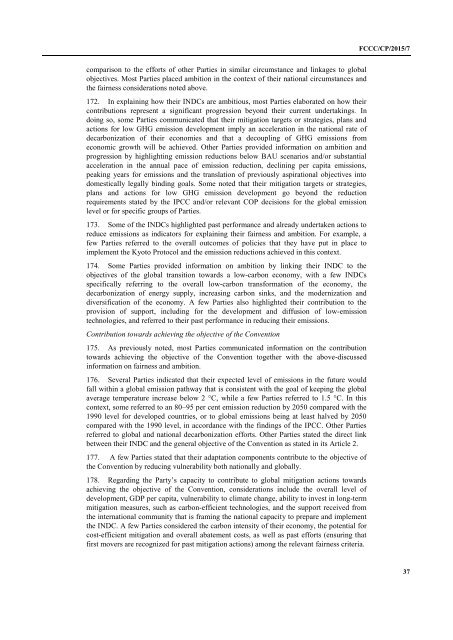FCCC/CP/2015/7
1PYuHQM
1PYuHQM
Create successful ePaper yourself
Turn your PDF publications into a flip-book with our unique Google optimized e-Paper software.
<strong>FCCC</strong>/<strong>CP</strong>/<strong>2015</strong>/7<br />
comparison to the efforts of other Parties in similar circumstance and linkages to global<br />
objectives. Most Parties placed ambition in the context of their national circumstances and<br />
the fairness considerations noted above.<br />
172. In explaining how their INDCs are ambitious, most Parties elaborated on how their<br />
contributions represent a significant progression beyond their current undertakings. In<br />
doing so, some Parties communicated that their mitigation targets or strategies, plans and<br />
actions for low GHG emission development imply an acceleration in the national rate of<br />
decarbonization of their economies and that a decoupling of GHG emissions from<br />
economic growth will be achieved. Other Parties provided information on ambition and<br />
progression by highlighting emission reductions below BAU scenarios and/or substantial<br />
acceleration in the annual pace of emission reduction, declining per capita emissions,<br />
peaking years for emissions and the translation of previously aspirational objectives into<br />
domestically legally binding goals. Some noted that their mitigation targets or strategies,<br />
plans and actions for low GHG emission development go beyond the reduction<br />
requirements stated by the IPCC and/or relevant COP decisions for the global emission<br />
level or for specific groups of Parties.<br />
173. Some of the INDCs highlighted past performance and already undertaken actions to<br />
reduce emissions as indicators for explaining their fairness and ambition. For example, a<br />
few Parties referred to the overall outcomes of policies that they have put in place to<br />
implement the Kyoto Protocol and the emission reductions achieved in this context.<br />
174. Some Parties provided information on ambition by linking their INDC to the<br />
objectives of the global transition towards a low-carbon economy, with a few INDCs<br />
specifically referring to the overall low-carbon transformation of the economy, the<br />
decarbonization of energy supply, increasing carbon sinks, and the modernization and<br />
diversification of the economy. A few Parties also highlighted their contribution to the<br />
provision of support, including for the development and diffusion of low-emission<br />
technologies, and referred to their past performance in reducing their emissions.<br />
Contribution towards achieving the objective of the Convention<br />
175. As previously noted, most Parties communicated information on the contribution<br />
towards achieving the objective of the Convention together with the above-discussed<br />
information on fairness and ambition.<br />
176. Several Parties indicated that their expected level of emissions in the future would<br />
fall within a global emission pathway that is consistent with the goal of keeping the global<br />
average temperature increase below 2 °C, while a few Parties referred to 1.5 °C. In this<br />
context, some referred to an 80–95 per cent emission reduction by 2050 compared with the<br />
1990 level for developed countries, or to global emissions being at least halved by 2050<br />
compared with the 1990 level, in accordance with the findings of the IPCC. Other Parties<br />
referred to global and national decarbonization efforts. Other Parties stated the direct link<br />
between their INDC and the general objective of the Convention as stated in its Article 2.<br />
177. A few Parties stated that their adaptation components contribute to the objective of<br />
the Convention by reducing vulnerability both nationally and globally.<br />
178. Regarding the Party’s capacity to contribute to global mitigation actions towards<br />
achieving the objective of the Convention, considerations include the overall level of<br />
development, GDP per capita, vulnerability to climate change, ability to invest in long-term<br />
mitigation measures, such as carbon-efficient technologies, and the support received from<br />
the international community that is framing the national capacity to prepare and implement<br />
the INDC. A few Parties considered the carbon intensity of their economy, the potential for<br />
cost-efficient mitigation and overall abatement costs, as well as past efforts (ensuring that<br />
first movers are recognized for past mitigation actions) among the relevant fairness criteria.<br />
37


